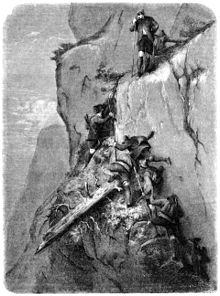Carl Trost

Carl Trost (also Karl Trost ; born April 25, 1811 in Eckernförde , † March 1, 1884 in Munich ) was a German painter , etcher , draftsman , illustrator and graphic artist .
Life
He was the son of a genius officer who initially worked in Hesse and then in Danish service . In 1817 the family moved to Northern Haiti at the invitation of King Henri Christophe , who had offered his father a position as an artillery officer . The local population, with their mixed French and Haitian language, and the diverse tropical nature exerted a lasting influence on the child. The family only managed to survive in the unfamiliar environment with great difficulty and to survive some tropical diseases . By falling from a horse, the child also got a broad forehead scar for life. After three years, his father asked for his release, fell out of favor and the family was imprisoned in the Fort Royal near Sans Souci . It was there that Carl made his first studies in drawing. In 1820, after the king's suicide , the family were released and given permission to return to Germany. Via Bremen and Fulda she reached Kassel , where the 16-year-old Carl was accepted into the family of his uncle, the court judge Friedrich Meisterlin , and was given the basics of further education.
In 1830 Trost moved to Munich to devote himself to history painting at the art academy there and with Peter von Hess . In 1834 he moved to Düsseldorf at the art academy there . In 1838 he went to Frankfurt to the Städelsche Kunstinstitut , worked with Philipp Veit and in 1842 with Jakob Becker . He made a name for himself with historical and religious depictions, family scenes and portraits and associated with colleagues such as Moritz von Schwind and Otto Donner von Richter and art patrons such as Franz von Bernus and Berthold Auerbach . For the interior design of the Kaisersaal in Frankfurt's Römer , he created the portraits of Ludwig the German and Karl the Fat . In 1848/49 he drew Ferdinand Freiligrath . He also illustrated books with etchings , including works by Friedrich Rückert , Ludwig Uhland , Ludwig Tieck and Grimms Märchen .
His wall paintings, including a Hubertus , made him known to Duke Ernst of Saxe-Coburg and Gotha , who brought him to Gotha , employed him from 1851 to 1859 and awarded him the title of court painter in 1856 . For him he created, among other things, a hunting album with portraits of wild game and dogs and a portrait that was shown at the Berlin academy exhibition in 1858.
He spent the rest of his life in Munich, interrupted from 1865 to 1867 by a three-year study visit to Italy, which took him to Venice and Rome , and a study trip to Paris . He published graphics in magazines such as the Gartenlaube and the Münchener Bilderbogen . His pictures found many buyers, including Prince Regent Luitpold of Bavaria , Franz von Bernus , Joseph Maillinger and the Münchner Kunstverein .
Works (selection)
Charlemagne ( Kaisersaal , Frankfurt am Main , 1840)
Winter garden at the Prinzenpalais ( Gotha , around 1859)
Titania from a Midsummer Night's Dream
literature
- Harald Bachmann, Wener Korn, Helmut Claus, Elisabeth Dobritzsch: Duke Ernst II of Saxe-Coburg and Gotha, 1818–1893 and his time. Anniversary publication on behalf of the cities of Coburg and Gotha. Maro Verlag, Augsburg 1993, ISBN 3-87512-198-8 .
- Consolation, Carl . In: Hans Vollmer (Hrsg.): General lexicon of fine artists from antiquity to the present . Founded by Ulrich Thieme and Felix Becker . tape 33 : Theodotos vacation . EA Seemann, Leipzig 1939, p. 433 .
- Allgemeine Zeitung , No. 118, April 28, 1884
- Julius Buddeus (ed.): German seals with marginal drawings by German artists , Düsseldorf 1849 ff. * Hyacinth Holland : Trost, Karl . In: Allgemeine Deutsche Biographie (ADB). Volume 38, Duncker & Humblot, Leipzig 1894, pp. 653-656.
- Kunstverein München : report ... 1884 , Munich 1884, p. 70
- Hans Paffrath (Ed.): Lexicon of the Düsseldorf School of Painting 1819–1918. Volume 3: Nabert-Zwecker. Published by the Kunstmuseum Düsseldorf in the Ehrenhof and by the Paffrath Gallery. Bruckmann, Munich 1998, ISBN 3-7654-3011-0 .
- Delia Miller: The Victorian Watercolors and Drawings: in the Collection of her Majesty the Queen . Philip Wilson, London 1995, ISBN 0-85667-436-2
Web links
- Literature by and about Carl Trost in the catalog of the German National Library
- Carl Trost at the Royal Collection Trust
Individual evidence
- ↑ Lippe B library FrS 2
- ↑ Buddeus 1849: Barbarossa , p. 29
- ^ Letter of July 21, 1865 about the sale of a "Rothkäppchen" picture, auction house Thomas Kotte, Rosshaupten. Retrieved June 19, 2017
- ↑ Bachmann et al. a. 1993 p. 403 ff
- ↑ Friedrich Gerstäcker : The chamois hunt . In: The Gazebo . Issue 1, 1857, pp. 12–13 ( full text [ Wikisource ] - Illustrations: The Rise and The Fall ).
- ↑ Duke Ernst von Coburg: A stalking walk on elephants in the eastern slopes of the Abyssinian rocky mountains . In: The Gazebo . Issue 32, 1862, pp. 500–503 ( full text [ Wikisource ]).
- ↑ Münchener Bilderbogen , No. 529: The best masterpiece . Schneider and Friedrich, Munich 1871
- ↑ Maillinger 1876. II. No. 2956 ff. Quoted. to Holland 1894
| personal data | |
|---|---|
| SURNAME | Consolation, Carl |
| ALTERNATIVE NAMES | Consolation, Karl |
| BRIEF DESCRIPTION | German painter |
| DATE OF BIRTH | April 25, 1811 |
| PLACE OF BIRTH | Eckernförde |
| DATE OF DEATH | March 1, 1884 |
| Place of death | Munich |






